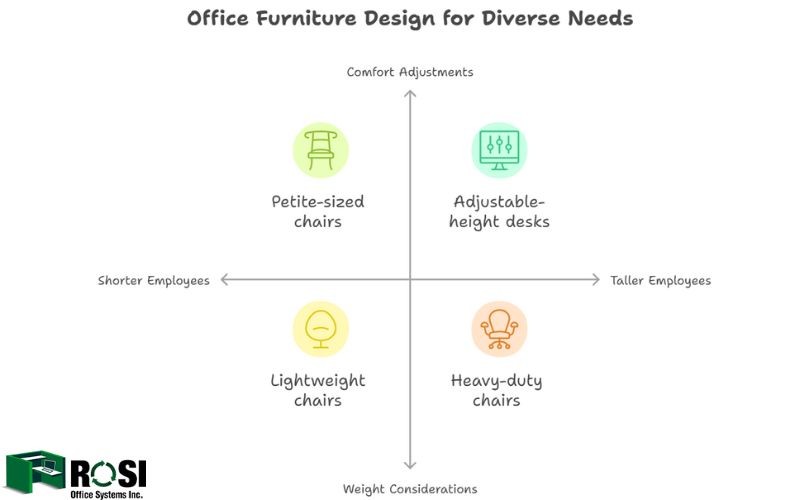
A Big and Tall Office Furniture Design
According to Health.com, the average male height is 69.5 inches (5 feet 9.5 inches) and the average waist size is 39.1 inches (and growing).
However, the basic rule of ergonomics is that there is no such thing as an “average” human. As companies strive to retain top talent, it becomes increasingly important to provide the proper office furniture in Houston and the space needed for a bigger or taller (or both) employee. But, how do you design an office with the bigger and taller than average employee in mind?
Sherry Scott, Project Consultant with ROSI Office Systems, Inc., recently shared her advice and insight in designing a productive office space for the big and tall employees in your company.
1. What are the challenges in outfitting a standard office space for a big or tall person?
Typically, the number one complaint is the underside of the desk hits their legs due to the standard height workspace being too low. Another common issue is the chair. The office chair is generally too low, including the arm height. In addition, the seat pan is too short and the office chair width is usually too tight for comfort. A standard chair weight threshold should also be considered. Most chairs hold weights up to just 250 lbs.
There are three contact areas in the workspace that affect the worker’s posture: the seat, the work surface (commonly it is a desktop or keyboard), and the floor. To ensure the most comfortable posture possible, two of these factors have to be adjustable.
2. What about public spaces?
For public areas, break areas, and guest seating, need to consider having a combination of arm and armless seating to accommodate the big or tall people. I ran across this request when testing a chair with arms for a large cafeteria/dining space.
Be sure to include bench/banquet seating with higher backs, along with a combination of armless and chairs with arms. Provide a variety to fit various sizes.
3. How can cubicles and office furniture be customized to fit a big or tall person? Is there an extra charge?
Cubicle systems or workstations are generally the best way to go. With systems applications, you can raise and lower the component heights and there is no extra charge if indicated on the plan before or in the field during installation.
Trip and service charges would be extra if not indicated to the installer before installation.
In one case, a gentleman was 7′-5″ and at a desk, so we built a platform to go under a standard executive desk and finished it out as close as possible to blend with the finish of the desk. Yes, extra charge for that one. But, you can also order higher glides or extend glides to raise the work surface height a bit. The extended glides are a nominal fee.
4. What office chair would you recommend for a big or tall person?
OTG has a LUXHIDE Management Chair OTG 11961B Big & Tall Executive Chair. It has a heavy-duty tilt mechanism, 350 lb weight capacity, standard 40-hour work week.
If it is a question of height and weight is not an issue, a lot of the new ergonomic task chair versions have pneumatic height adjustment, come with seat pan adjustments or extensions, adjustable arm height, and adjustable arm width.
Some also provide attachable headrests or higher backs. Lumbar adjustments are also available.
Examples are: Global Concorde, Global Alero, Global Aspen, and Global Truform.
6. In addition, the shorter than average have difficulties also! What are some considerations?
Standard work surface heights are too high. These can be lowered, just as we mentioned raising them above in #3. ROSI can lower the work surface, shelves, and binder bin heights to accommodate them.
Chairs are generally too deep, feet don’t touch the floor, too wide, arm heights are too high, and chairs can be too bulky and heavy to move them easily, both in desk chairs and guest chairs.
Some furniture lines carry a more petite version. (Herman Miller Aeron Size A Chair, they also carry a B size Medium and a C size large version.
Three contact areas in the workspace affect the worker’s posture: the seat, the work surface (commonly it is a desktop or keyboard), and the floor. To ensure the most comfortable posture possible, two of these factors have to be adjustable.
During a free space planning session with ROSI, be sure to mention your specific needs so we may create a plan that effectively addresses any special employee needs.

John Ofield is a recognized expert in the office furniture and office cubicle industry, with over 40 years of experience. As the founder of ROSI Office Systems, he specializes in space planning, custom cubicle designs, and high-quality commercial furniture. John’s expertise helps businesses enhance productivity and collaboration. He is also dedicated to mentoring entrepreneurs and redefining workspaces to inspire success.



